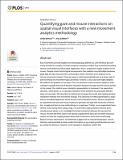Files in this item
Quantifying gaze and mouse interactions on spatial visual interfaces with a new movement analytics methodology
Item metadata
| dc.contributor.author | Demšar, Urška | |
| dc.contributor.author | Çöltekin, Arzu | |
| dc.date.accessioned | 2017-08-07T09:30:15Z | |
| dc.date.available | 2017-08-07T09:30:15Z | |
| dc.date.issued | 2017-08-04 | |
| dc.identifier | 250537402 | |
| dc.identifier | a532183c-53cd-40b1-80bc-c521358c95eb | |
| dc.identifier | 85026812809 | |
| dc.identifier | 000406944300015 | |
| dc.identifier.citation | Demšar , U & Çöltekin , A 2017 , ' Quantifying gaze and mouse interactions on spatial visual interfaces with a new movement analytics methodology ' , PLoS One , vol. 12 , no. 8 . https://doi.org/10.1371/journal.pone.0181818 | en |
| dc.identifier.issn | 1932-6203 | |
| dc.identifier.other | ORCID: /0000-0001-7791-2807/work/48516829 | |
| dc.identifier.uri | https://hdl.handle.net/10023/11395 | |
| dc.description | This research was supported by the Royal Society International Exchange Programme (grant no. IE120643). | en |
| dc.description.abstract | Eye movements provide insights into what people pay attention to, and therefore are commonly included in a variety of human-computer interaction studies. Eye movement recording devices (eye trackers) produce gaze trajectories, that is, sequences of gaze location on the screen. Despite recent technological developments that enabled more affordable hardware, gaze data are still costly and time consuming to collect, therefore some propose using mouse movements instead. These are easy to collect automatically and on a large scale. If and how these two movement types are linked, however, is less clear and highly debated. We address this problem in two ways. First, we introduce a new movement analytics methodology to quantify the level of dynamic interaction between the gaze and the mouse pointer on the screen. Our method uses volumetric representation of movement, the space-time densities, which allows us to calculate interaction levels between two physically different types of movement. We describe the method and compare the results with existing dynamic interaction methods from movement ecology. The sensitivity to method parameters is evaluated on simulated trajectories where we can control interaction levels. Second, we perform an experiment with eye and mouse tracking to generate real data with real levels of interaction, to apply and test our new methodology on a real case. Further, as our experiment tasks mimics route-tracing when using a map, it is more than a data collection exercise and it simultaneously allows us to investigate the actual connection between the eye and the mouse. We find that there seem to be natural coupling when eyes are not under conscious control, but that this coupling breaks down when instructed to move them intentionally. Based on these observations, we tentatively suggest that for natural tracing tasks, mouse tracking could potentially provide similar information as eye-tracking and therefore be used as a proxy for attention. However, more research is needed to confirm this. | |
| dc.format.extent | 36 | |
| dc.format.extent | 18324012 | |
| dc.language.iso | eng | |
| dc.relation.ispartof | PLoS One | en |
| dc.subject | Human-Computer Interaction | en |
| dc.subject | Eye Tracking | en |
| dc.subject | Mouse Tracking | en |
| dc.subject | Hand-Eye coordination | en |
| dc.subject | Movement Analytics | en |
| dc.subject | Movement Visualization | en |
| dc.subject | Geographic Information Science | en |
| dc.subject | RC0321 Neuroscience. Biological psychiatry. Neuropsychiatry | en |
| dc.subject | DAS | en |
| dc.subject.lcc | RC0321 | en |
| dc.title | Quantifying gaze and mouse interactions on spatial visual interfaces with a new movement analytics methodology | en |
| dc.type | Journal article | en |
| dc.contributor.sponsor | The Royal Society | en |
| dc.contributor.institution | University of St Andrews. School of Geography & Sustainable Development | en |
| dc.contributor.institution | University of St Andrews. Bell-Edwards Geographic Data Institute | en |
| dc.identifier.doi | https://doi.org/10.1371/journal.pone.0181818 | |
| dc.description.status | Peer reviewed | en |
| dc.identifier.url | http://journals.plos.org/plosone/article?id=10.1371/journal.pone.0181818#sec032 | en |
| dc.identifier.grantnumber | IE120643 | en |
This item appears in the following Collection(s)
Items in the St Andrews Research Repository are protected by copyright, with all rights reserved, unless otherwise indicated.

